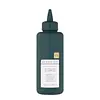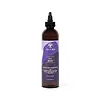What's inside
What's inside
 Key Ingredients
Key Ingredients

 Benefits
Benefits

 Concerns
Concerns

 Ingredients Side-by-side
Ingredients Side-by-side

Water
Skin ConditioningSodium Lauroyl Methyl Isethionate
CleansingCocamidopropyl Betaine
CleansingGlycerin
HumectantOleth-5
EmulsifyingParfum
MaskingPhenoxyethanol
PreservativeDisteareth-100 Ipdi
Sodium Lauroamphoacetate
CleansingSodium Benzoate
MaskingCitric Acid
BufferingPolyquaternium-10
Potassium Sorbate
PreservativePolyquaternium-7
Panthenol
Skin ConditioningTrisodium Ethylenediamine Disuccinate
Butylene Glycol
HumectantHydrolyzed Pea Protein
EmollientChamomilla Recutita Flower Extract
MaskingEquisetum Hyemale Leaf/Stem Extract
Skin ConditioningEucalyptus Globulus Leaf Extract
PerfumingHydrolyzed Rice Protein
Skin ConditioningSalvia Officinalis Leaf Extract
CleansingAloe Barbadensis Leaf Juice
Skin ConditioningAlgin
MaskingCaprylic/Capric Triglyceride
MaskingCarrageenan
Chitosan
Coco-Glucoside
CleansingCocos Nucifera Fruit Extract
EmollientGuar Hydroxypropyltrimonium Chloride
Skin ConditioningHelianthus Annuus Seed Oil
EmollientLavandula Angustifolia Extract
Skin ConditioningMangifera Indica Seed Butter
Skin ConditioningPersea Gratissima Oil
Skin ConditioningRicinus Communis Seed Oil
MaskingSorbitan Oleate
EmulsifyingXanthan Gum
EmulsifyingWater, Sodium Lauroyl Methyl Isethionate, Cocamidopropyl Betaine, Glycerin, Oleth-5, Parfum, Phenoxyethanol, Disteareth-100 Ipdi, Sodium Lauroamphoacetate, Sodium Benzoate, Citric Acid, Polyquaternium-10, Potassium Sorbate, Polyquaternium-7, Panthenol, Trisodium Ethylenediamine Disuccinate, Butylene Glycol, Hydrolyzed Pea Protein, Chamomilla Recutita Flower Extract, Equisetum Hyemale Leaf/Stem Extract, Eucalyptus Globulus Leaf Extract, Hydrolyzed Rice Protein, Salvia Officinalis Leaf Extract, Aloe Barbadensis Leaf Juice, Algin, Caprylic/Capric Triglyceride, Carrageenan, Chitosan, Coco-Glucoside, Cocos Nucifera Fruit Extract, Guar Hydroxypropyltrimonium Chloride, Helianthus Annuus Seed Oil, Lavandula Angustifolia Extract, Mangifera Indica Seed Butter, Persea Gratissima Oil, Ricinus Communis Seed Oil, Sorbitan Oleate, Xanthan Gum
Water
Skin ConditioningLauramidopropyl Hydroxysultaine
CleansingBetaine
HumectantSodium Chloride
MaskingOryza Sativa Extract
AbsorbentCeramide NP
Skin ConditioningBiotin
AntiseborrhoeicPhytosterols
Skin ConditioningInositol
HumectantCopper Tripeptide-1
Skin ConditioningSerenoa Serrulata Fruit Extract
Skin ConditioningSodium Salicylate
PreservativePolyquaternium-10
Citric Acid
BufferingEthylhexylglycerin
Skin Conditioning1,2-Hexanediol
Skin ConditioningPotassium Sorbate
PreservativeSodium Benzoate
MaskingWater, Lauramidopropyl Hydroxysultaine, Betaine, Sodium Chloride, Oryza Sativa Extract, Ceramide NP, Biotin, Phytosterols, Inositol, Copper Tripeptide-1, Serenoa Serrulata Fruit Extract, Sodium Salicylate, Polyquaternium-10, Citric Acid, Ethylhexylglycerin, 1,2-Hexanediol, Potassium Sorbate, Sodium Benzoate
 Reviews
Reviews

Alternatives
Ingredients Explained
These ingredients are found in both products.
Ingredients higher up in an ingredient list are typically present in a larger amount.
Citric Acid is an alpha hydroxy acid (AHA) naturally found in citrus fruits like oranges, lemons, and limes.
Like other AHAs, citric acid can exfoliate skin by breaking down the bonds that hold dead skin cells together. This helps reveal smoother and brighter skin underneath.
However, this exfoliating effect only happens at high concentrations (20%) which can be hard to find in cosmetic products.
Due to this, citric acid is usually included in small amounts as a pH adjuster. This helps keep products slightly more acidic and compatible with skin's natural pH.
In skincare formulas, citric acid can:
While it can provide some skin benefits, research shows lactic acid and glycolic acid are generally more effective and less irritating exfoliants.
Most citric acid used in skincare today is made by fermenting sugars (usually from molasses). This synthetic version is identical to the natural citrus form but easier to stabilize and use in formulations.
Read more about some other popular AHA's here:
Learn more about Citric AcidPolyquaternium-10 is an ammonium salt of hydroxyethylcellulose. It is a white and granular powder used as a film-former and anti-static agent.
This ingredient is commonly found in hair conditioning products. According to a manufacturer, its positive charge makes it great for absorbing hair proteins. The manufacturer also states this ingredient helps with curl retention.
For haircare friends: this ingredient is not a silicone.
Learn more about Polyquaternium-10Potassium Sorbate is a preservative used to prevent yeast and mold in products. It is commonly found in both cosmetic and food products.
This ingredient comes from potassium salt derived from sorbic acid. Sorbic acid is a natural antibiotic and effective against fungus.
Both potassium sorbate and sorbic acid can be found in baked goods, cheeses, dried meats, dried fruit, ice cream, pickles, wine, yogurt, and more.
You'll often find this ingredient used with other preservatives.
Learn more about Potassium SorbateSodium Benzoate is a preservative. It's used in both cosmetic and food products to inhibit the growth of mold and bacteria. It is typically produced synthetically.
Both the US FDA and EU Health Committee have approved the use of sodium benzoate. In the US, levels of 0.1% (of the total product) are allowed.
Sodium benzoate works as a preservative by inhibiting the growth of bacteria inside of cells. It prevents the cell from fermenting a type of sugar using an enzyme called phosphofructokinase.
It is the salt of benzoic acid. Foods containing sodium benzoate include soda, salad dressings, condiments, fruit juices, wines, and snack foods.
Studies for using ascorbic acid and sodium benzoate in cosmetics are lacking, especially in skincare routines with multiple steps.
We always recommend speaking with a professional, such as a dermatologist, if you have any concerns.
Learn more about Sodium BenzoateWater. It's the most common cosmetic ingredient of all. You'll usually see it at the top of ingredient lists, meaning that it makes up the largest part of the product.
So why is it so popular? Water most often acts as a solvent - this means that it helps dissolve other ingredients into the formulation.
You'll also recognize water as that liquid we all need to stay alive. If you see this, drink a glass of water. Stay hydrated!
Learn more about Water